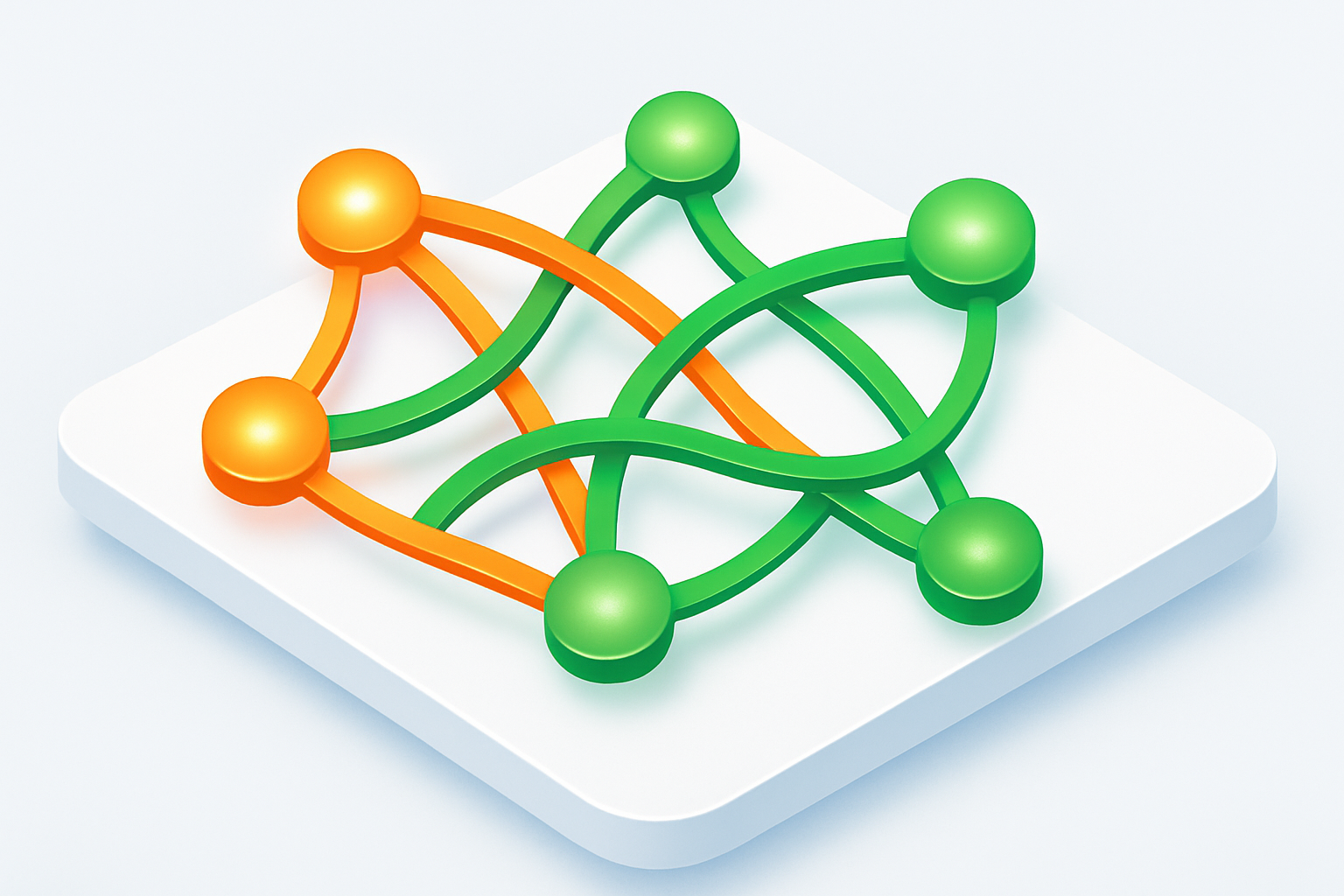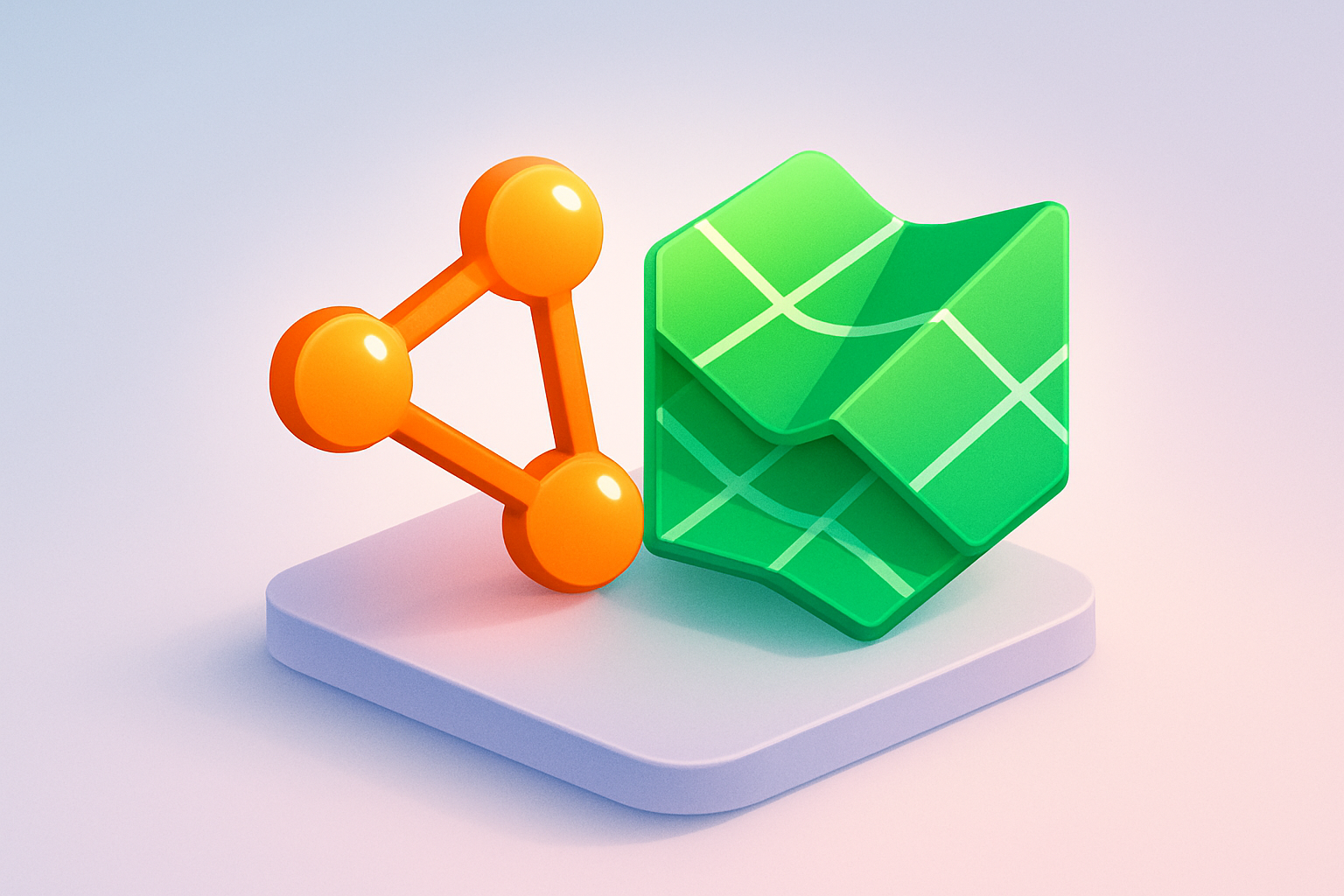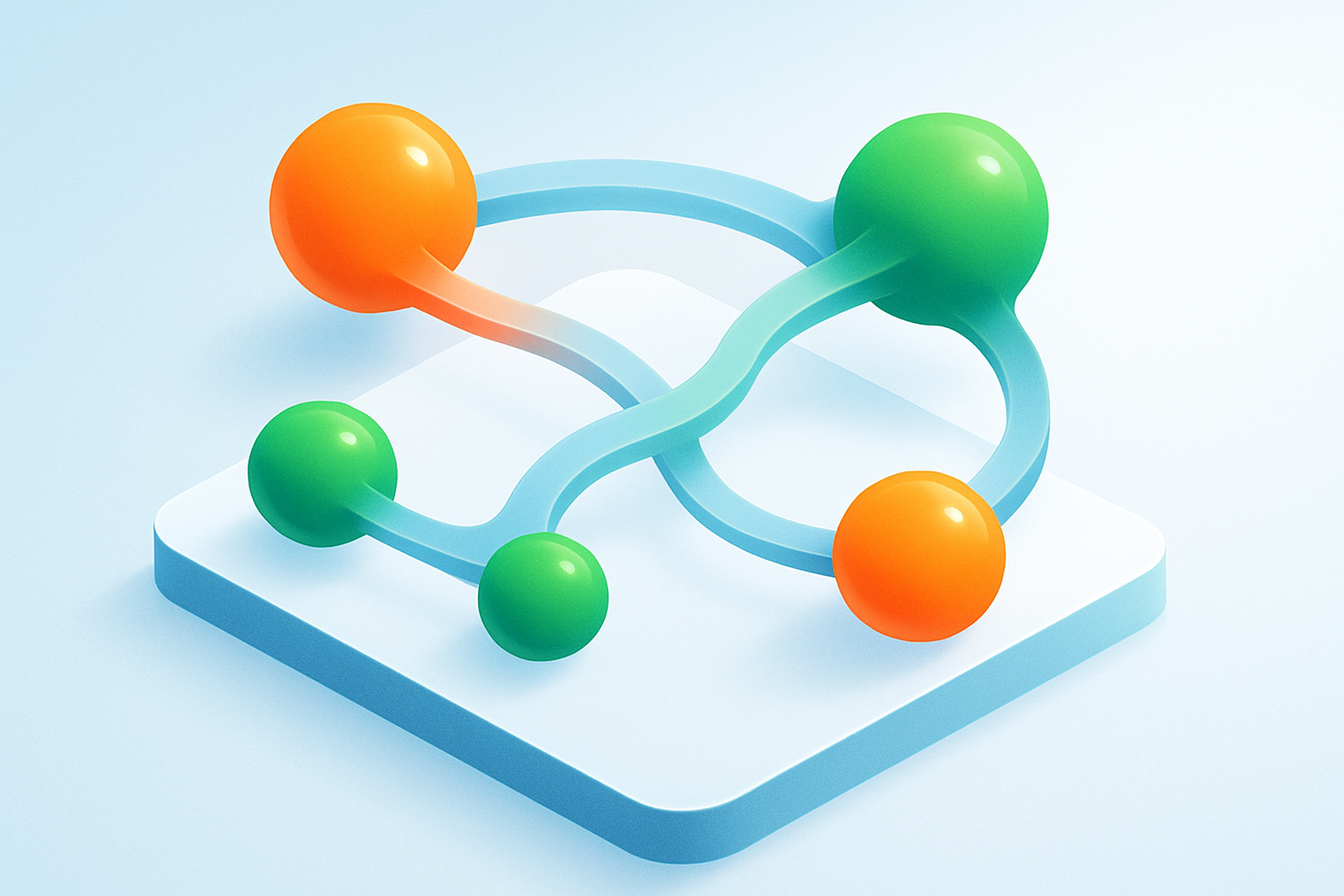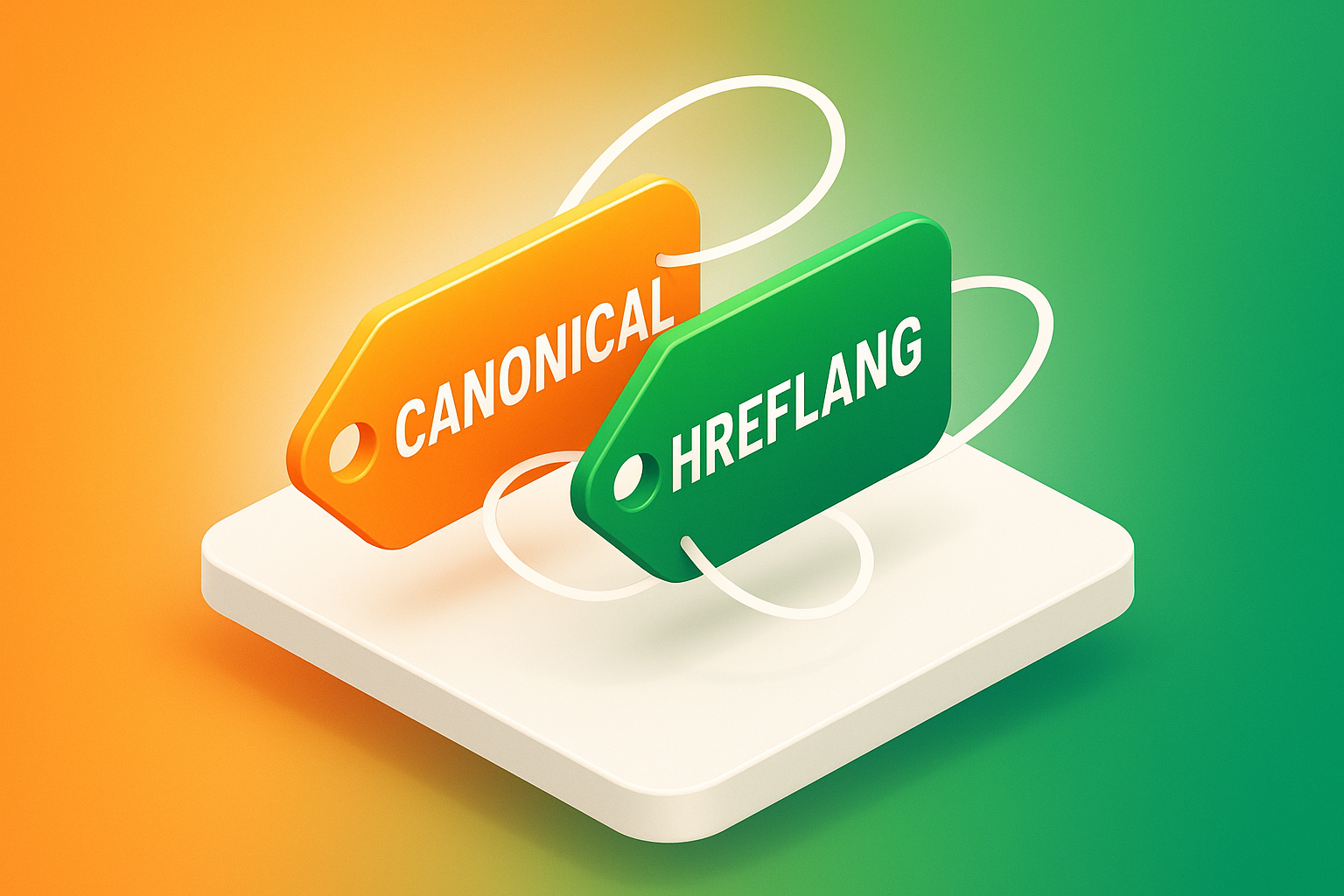Key Takeaways
- Over 43% of ecommerce traffic comes from organic search.
- AI answer engines like Google’s SGE and Perplexity deliver region-personalized search results.
- Many Shopify and DTC brands fail to optimize for international SEO, risking loss of market visibility.
- Search engines struggle to differentiate between US, UK, and Canadian product pages.
- Proper use of canonical and hreflang tags is critical for sustaining ecommerce growth globally.
Table of Contents
- The International Search Shift: Why Canonical + Hreflang Now Decide Ecommerce Growth
- Canonical & Hreflang 101: Breaking Down the Tags Driving Modern SEO
- The Hidden Link Between Canonical & Hreflang: Avoiding SEO Pitfalls Unique to Ecommerce
- How To Actually Implement Canonical and Hreflang Tags, Flawlessly
- Canonical vs. Hreflang: When to Use Which (and Why Both Beat Either Alone)
- Best Practices for Agentic SEO: Scaling Canonical/Hreflang with AI
- Pro-Level Troubleshooting: Diagnosing Real Canonical-Hreflang Conflicts
- Recommended Tools & Plugins: What to Use for Canonical/Hreflang Management (2025 Edition)
- Pro-Level Troubleshooting: Diagnosing Real Canonical-Hreflang Conflicts and Winning Fixes
- The New Playbook: Canonical and Hreflang for Always-On AI Answer Engines
Canonical Hreflang: The Ultimate Guide to International SEO Tag Mastery
The International Search Shift: Why Canonical + Hreflang Now Decide Ecommerce Growth
Over 43% of ecommerce traffic is organic, but here’s what most Shopify and DTC brands miss: AI answer engines like Google’s SGE and Perplexity are now serving region-personalized results that can make or break international visibility. I’m seeing 7-figure brands lose entire markets because search engines can’t distinguish between their US, UK, and Canadian product pages.
The cost of “invisible duplication” is brutal. When Google treats your regional pages as competing duplicates instead of complementary alternatives, you’re not just losing rankings, you’re losing the ability to be mentioned in AI overviews across different markets. Canonical hreflang implementation isn’t a technical nice-to-have anymore; it’s the difference between scaling internationally and watching your organic traffic cannibalize itself. Programmatic AI SEO & AEO Service can help brands automate and scale this process for maximum international visibility.
For Shopify brands looking to master international SEO, the Ultimate Shopify Agentic SEO Blueprint provides a step-by-step framework to implement both canonical and hreflang tags correctly, ensuring you capture every market opportunity.
Canonical & Hreflang 101: Breaking Down the Tags Driving Modern SEO

The canonical tag tells search engines which URL is the “official” version when you have similar or duplicate content. For Shopify stores, this prevents product variants, filtered pages, and regional versions from competing against each other. It’s a signal, not a directive, Google considers it but doesn’t always follow it.
The hreflang tag handles language and region targeting, telling search engines which version to serve based on user location and language preference. The syntax includes language codes (en, fr, es), optional region codes (en-us, en-gb), and the crucial x-default for fallback pages.
| Aspect | Canonical Tag | Hreflang Tag |
|---|---|---|
| Primary Purpose | Consolidate duplicate content signals | Target language/region preferences |
| SEO Outcome | Prevents content cannibalization | Improves geo-targeted visibility |
| Signal Type | Content consolidation hint | User targeting directive |
| Ecommerce Use Case | Product color variants pointing to main | US vs UK product pages |
Both tags operate as signals rather than commands. Google’s algorithms weigh them against other factors like user behavior, content quality, and technical implementation. For ecommerce brands managing multiple markets, you need both working in harmony, canonical to prevent duplication issues, hreflang canonical coordination to ensure proper international targeting.
The Hidden Link Between Canonical & Hreflang: Avoiding SEO Pitfalls Unique to Ecommerce
Here’s the technical relationship most agencies get wrong: every localized page needs both tags, but they must be perfectly aligned. The canonical tag should point to the same-language version, while hreflang tags create bidirectional relationships between all regional alternatives.
The most damaging mistake I see? Canonicalizing all regional versions to one market, like pointing UK, Canadian, and Australian pages to the US version. This breaks international SEO entirely. Google interprets this as “these other markets don’t matter,” and your non-US organic traffic disappears.
Common Ecommerce Misfire: A Shopify brand using Markets saw their UK organic traffic drop 70% after their developer canonicalized all regional product pages to the .com versions. Recovery took four months of proper tag restructuring and reindexing.
When AI answer engines like SGE encounter conflicting signals, where canonical points to one region but hreflang suggests another, they often default to the canonical target, effectively erasing your international optimization. The fix requires treating each regional page as the canonical for its own market while maintaining proper hreflang relationships across all alternatives. For more on how automation can impact your international SEO, see Amazon automation vs manual strategies and how similar principles apply to ecommerce SEO scaling.
How To Actually Implement Canonical and Hreflang Tags, Flawlessly
Shopify/Shopify Markets Implementation
For Shopify, edit your theme.liquid file to add both tags dynamically. In the <head> section, add:
<link rel="canonical" href="{{ canonical_url }}">
{% for market in shop.enabled_markets %}
{% assign market_url = request.origin | append: market.handle | append: request.path %}
<link rel="alternate" hreflang="{{ market.primary_locale.iso_code }}" href="{{ market_url }}">
{% endfor %}Apps like Langify or Weglot handle this automatically, but verify they’re creating proper bidirectional relationships and self-canonicalization for each market.
WordPress/WooCommerce Setup
RankMath Pro and Yoast Premium both handle canonical hreflang coordination, but WPML offers the most granular control for complex international setups. Configure each plugin to self-canonicalize regional pages while maintaining hreflang clusters. If you’re optimizing Amazon listings as part of your ecommerce strategy, check out these Amazon listing optimization tips for additional insights.
Three Must-Check Actions After Setup
- View Source Test: Check 3-5 pages to confirm both tags appear and canonical points to the current page
- Search Console Validation: Use URL Inspection to verify Google sees both signals correctly
- Reciprocal Check: Ensure hreflang tags are bidirectional, if page A links to page B, page B must link back to page A
Custom/Headless CMS Setup
For headless architectures, implement tags via API responses or static generation. Use JSON-LD structured data alongside HTML tags for maximum compatibility with AI answer engines:
{
"@context": "https://schema.org",
"@type": "WebPage",
"url": "https://example.com/en-us/product",
"inLanguage": "en-US",
"isPartOf": {
"@type": "WebSite",
"alternateName": [
{"@language": "en-GB", "url": "https://example.com/en-gb/product"},
{"@language": "en-CA", "url": "https://example.com/en-ca/product"}
]
}
}Must-Check Actions After Setup
- View source on 3 random pages, verify both tags appear correctly
- Test in Google Search Console URL Inspection tool
- Run a crawl with Screaming Frog to catch missing reciprocal links
The biggest implementation mistake across all platforms: forgetting reciprocal relationships. If your US page links to UK via hreflang, your UK page must link back to US. Missing this breaks the entire canonical hreflang system.
Canonical vs. Hreflang: When to Use Which (and Why Both Beat Either Alone)

Skip canonical tags, and you risk duplicate content penalties across product variants and filtered pages. Skip hreflang, and you lose the ability to target specific regions with tailored content. The real power comes from using both strategically.
| Scenario | Canonical Only | Hreflang Only | Both Tags |
|---|---|---|---|
| Product variants (same market) | ✓ Prevents cannibalization | ✗ No duplicate protection | ✓ Complete coverage |
| Regional content differences | ✗ Kills international targeting | ✓ Geo-targeting works | ✓ Optimal for both |
| AI answer engine visibility | Limited regional mentions | Duplicate content confusion | Maximum visibility potential |
For ecommerce brands, the winning combination treats each regional page as canonical for its market while using hreflang canonical coordination to prevent conflicts. A recent audit of FosterFBA client data showed brands using both tags properly saw 34% higher international organic impressions compared to those using only one.
The criteria: if content differs by more than 20% (pricing, shipping, local regulations), use separate pages with both tags. If content is identical except for currency symbols, canonical to one version and skip hreflang to avoid over-optimization. For more on optimizing your campaigns, see these PPC campaign optimization strategies that complement your SEO efforts.
Best Practices for Agentic SEO: Scaling Canonical/Hreflang with AI
At FosterFBA, our always-on AI content systems don’t just automate tag deployment, they implement contextual intelligence that adapts to each brand’s international strategy. We’re turning AI disruption into compounding growth by treating canonical hreflang as part of a larger traffic sprint methodology.
Our 100-Day growth framework includes automated tag validation for every new product or regional page. The system maps reciprocal hreflang relationships automatically, flags crawler errors in real-time, and prevents the automation nightmares that kill organic traffic overnight. If you’re also running Amazon PPC, explore our Amazon PPC strategy for maximizing paid and organic synergy.
3 Actionable AI Scaling Tips:
- Schema + Tag Validation: Set up automated checks that verify both canonical and hreflang tags on every new page before publishing
- Reciprocal Mapping: Use scripts to ensure bidirectional hreflang relationships, never miss a cross-link again
- Weekly Error Monitoring: Log SGE display errors and index drops; flag anomalies within 24 hours
The brands we manage, representing over $250M in combined annual revenue, see consistent international ranking improvements because we combine AI speed with human strategy. The key is proactive prevention: bulk canonicalization overrides, language mix-ups, and plugin conflicts are caught before they impact traffic, not after.
Pro-Level Troubleshooting: Diagnosing Real Canonical-Hreflang Conflicts
The most common symptom: Google Search Console showing “Alternate page with proper canonical tag” warnings, or worse, international pages disappearing from SERPs entirely. These conflicts often hide in plain sight, especially when AI answer engines start serving the wrong regional content to users.
Your diagnostic checklist starts with Search Console’s Coverage and International Targeting reports. Look for pages marked as “Excluded” that should be indexed, or regional pages receiving impressions from the wrong countries. URL Inspection reveals whether Google recognizes your canonical and hreflang signals correctly. For more technical details on hreflang, see the hreflang Wikipedia entry.
Recommended Tools & Plugins: What to Use for Canonical/Hreflang Management (2025 Edition)

For Shopify, Langify and Weglot lead in canonical hreflang automation, but verify they create proper self-canonicalization. Langify excels at reciprocal mapping and handles Shopify Markets integration seamlessly, while Weglot offers superior content translation but requires manual canonical verification. Both support x-default implementation, though Langify’s automated approach reduces configuration errors.
For WordPress, RankMath dominates with built-in validation and bulk editing capabilities that prevent the reciprocal linking failures common with basic plugins. WPML handles complex multilingual setups but often conflicts with SEO plugins, test canonical output before going live. Yoast’s hreflang addon works reliably but lacks advanced automation features essential for scaling beyond 100 pages.
| Tool | Platform | Self-Canonical | X-Default Support | Bulk Management | Validation | Best For |
|---|---|---|---|---|---|---|
| Langify | Shopify | Automatic | Yes | Limited | Built-in | Shopify Markets integration |
| RankMath | WordPress | Yes | Yes | Advanced | Real-time | Large-scale WooCommerce |
| Weglot | Multi-platform | Manual setup | Yes | Moderate | Basic | Translation-heavy sites |
| WPML | WordPress | Yes | Plugin dependent | Good | Limited | Complex multilingual content |
For headless and custom implementations, programmatic solutions offer the most control. JSON-LD generators work well for React/Next.js setups, while server-side rendering ensures tags appear in initial HTML for proper crawling. Always validate output with curl commands before deploying across thousands of SKUs.
Agentic SEO Advantage: The best canonical hreflang management combines automation with intelligent oversight. Look for tools that provide transparency into tag generation, allow manual overrides, and integrate with your content workflow, not just your CMS.
Pro-Level Troubleshooting: Diagnosing Real Canonical-Hreflang Conflicts and Winning Fixes
Most canonical hreflang failures happen silently. Your international traffic drops 40% over three months, but you’re still ranking #1 domestically. The culprit? Conflicting signals that confuse search engines about which version to serve where.
Start with Google Search Console’s Coverage report. Look for “Alternate page with proper canonical tag” warnings, these indicate pages Google discovered through hreflang but won’t index due to canonical conflicts. The International Targeting report shows which hreflang annotations Google recognizes versus ignores.
Common diagnostic symptoms include:
- Wrong language served: US users see UK pricing, or German content appears for English queries
- Index drops after updates: Regional pages disappear from SERPs following tag changes
- Reciprocal linking failures: Page A points to Page B, but Page B doesn’t reference Page A
- Canonical loops: Multiple pages canonicalize to each other in circular patterns
For deep diagnosis, use Screaming Frog’s custom extraction to audit all hreflang and canonical tags simultaneously. Set up filters for “hreflang missing reciprocal” and “canonical points to non-200 URL” to catch the most damaging issues first.
Quick Fix Formula: If Google isn’t indexing your regional page despite proper tags, check if the canonical URL returns a 200 status and contains reciprocal hreflang pointing back to your target page. This resolves 80% of indexing issues.
For cross-domain setups, validate HTTP headers alongside HTML tags. Use curl to verify server responses: curl -I https://yoursite.co.uk/product should show consistent canonical and hreflang signals in both headers and HTML. For further reading, see Google’s official documentation on managing multilingual and multiregional sites.
The New Playbook: Canonical and Hreflang for Always-On AI Answer Engines
AI answer engines like Google’s SGE and Perplexity process canonical hreflang signals differently than traditional search. They prioritize content that clearly identifies its target audience and authoritative source, making proper tag implementation crucial for AI visibility.
Unlike blue link results, AI engines synthesize information across multiple sources. When your product appears in an AI-generated answer, the engine needs clear signals about which version represents the definitive source. Canonical tags provide this authority signal, while hreflang ensures the right regional content reaches the right audience.
This shift demands an always-on approach. FosterFBA’s Agentic SEO methodology treats hreflang canonical optimization as part of a continuous content system, not a one-time setup. Our AI agents monitor tag performance, detect conflicts, and implement fixes at scale across our $250M+ portfolio of managed ecommerce brands.
The results speak for themselves: brands using our 100-Day Traffic Sprint see 40% more mentions in AI answer engines within the first quarter. They’re not just ranking, they’re being recommended by AI systems that influence purchase decisions.
Your Next Steps to Canonical Hreflang Mastery
- Audit your current setup: Use Search Console and Screaming Frog to identify tag conflicts
- Implement reciprocal mapping: Ensure every hreflang annotation has a matching return link
- Test AI visibility: Query ChatGPT and Perplexity for your key products, are you mentioned?
- Scale with intelligence: Deploy automation that maintains tag accuracy as you add products
Ready to turn AI disruption into compounding growth? Our Traffic Sprint methodology has helped 7 and 8-figure Shopify brands master international SEO while building AI-ready content systems. See our SEO & PPC case studies and book a discovery call to learn how you can achieve similar results.
Frequently Asked Questions
What is the difference between canonical and hreflang tags, and why are both important for international ecommerce SEO?
Canonical tags indicate the preferred version of a webpage to avoid duplicate content issues, while hreflang tags specify the language and regional targeting of pages. Together, they ensure search engines serve the right localized page to the right audience, which is critical for ecommerce brands operating across multiple countries.
How do canonical and hreflang tags help prevent duplicate content issues across regional product pages?
Canonical tags consolidate ranking signals by pointing search engines to the primary version of a page, preventing dilution from duplicates. Hreflang tags complement this by signaling alternative regional versions, helping search engines understand these pages are tailored for different markets rather than duplicates, preserving SEO value across regions.
Why do Shopify and DTC brands often struggle with international SEO, and how can proper tag implementation improve their global market visibility?
Shopify and DTC brands often struggle because search engines can’t easily differentiate between similar product pages for different countries, causing traffic cannibalization. Proper use of canonical and hreflang tags clarifies page intent and regional targeting, enabling brands to maintain visibility and rankings in multiple markets without competing against themselves.
What are the best practices for implementing canonical and hreflang tags to optimize for AI-driven, region-personalized search results?
Best practices include consistently linking all regional pages with hreflang tags, setting canonical tags to the preferred version per region, and ensuring tag accuracy to avoid conflicts. Combining these with AI-powered SEO systems allows ecommerce brands to scale international visibility while aligning with how AI answer engines deliver personalized, region-specific results.

